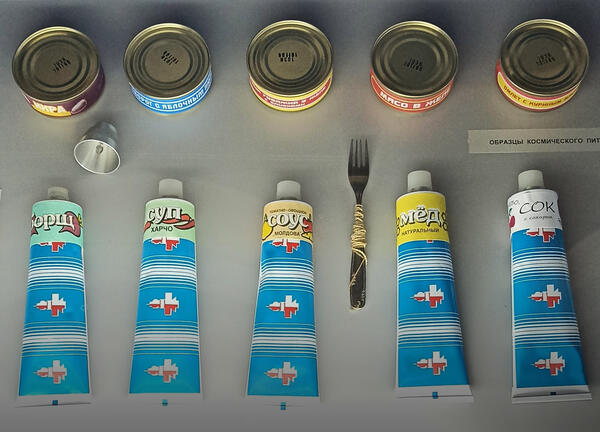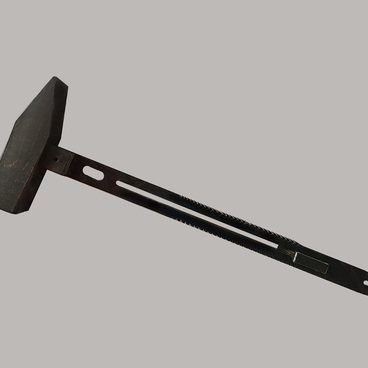The museum displays samples of space food produced at the BiryulYOvsky plant in the Moscow region. This enterprise has been producing food for astronauts for more than 50 years. During this time special technologies for production of ‘space’ products were developed there.
The first food for use in space was prepared for the flight of Laika the dog in 1957. It was a jelly-like nutrient compound that was fed through an automatic container. Astronauts, on their first flights - that lasted several hours - either did not eat at all or took with them normal Earth products. But when the flight time was approaching 24 hours, it became impossible to do without special food: conventional products quickly deteriorate and it is uncomfortable to eat them in weightlessness. Space diets have been developed by the Research Institute of the Food-concentrates Industry and Special Food Technology, together with the Institute of Biomedical Problems.
Gagarin’s flight was relatively short - 108 minutes. One of the goals was to test space food. Of all the options, it was decided to focus on the food that was previously tested in the aviation industry. The rations for the 2-hour flight were modest: meat and chocolate in tubes of 160 grams. While GhErman TitOv’s flight lasted 25 hours, and he had three meals. The dishes included: liver pâté, vegetable cream soup and black currant juice. However, after Titov’s return, he noted a strong feeling of hunger, which reached the level of dizziness: the calorific capacity of his diet was clearly inadequate. Therefore, dietary planners have begun to pay particular attention to nutrition as well as to the way in which food is digested. They added sirloin steak, beef tongue, chops, chicken fillets, borscht, rye bread.
Currently BiryulYOvsky plant produces 90% of the products included in the diet of astronauts - all except cheese, bread and fish dishes.
Food products must meet a number of criteria in order to be considered fit for astronauts. The food should be nutritious and tasty, easily digested and suitable for consumption of weightlessness. And have minimum weight, have a good storage life, easy to open and not leave crumbs and much litter after use.
If at the dawn of the space age most of the products were in the tubes, they are now mostly sublimated products. Sublimation is dehydration. First, a product is frozen to -50 degrees Celsius, then it is vacuum-dried, then heated to +50-70 degrees for 32 hours. Sublimation does not convert the ice into water, but immediately evaporates, and the valuable substances that usually come out with the moisture remain. The astronauts admit that one of the most delicious sublimated products is cottage cheese with cranberries and nuts. It tastes like it’s fresh. Before drawing up a ration (individually for each participant of the expedition), both the American and the Russian Space Training Centre conduct a tasting session. Astronauts rate the proposed dishes on a scale of one to ten: the ones that scored five or less do not get on board.
The first food for use in space was prepared for the flight of Laika the dog in 1957. It was a jelly-like nutrient compound that was fed through an automatic container. Astronauts, on their first flights - that lasted several hours - either did not eat at all or took with them normal Earth products. But when the flight time was approaching 24 hours, it became impossible to do without special food: conventional products quickly deteriorate and it is uncomfortable to eat them in weightlessness. Space diets have been developed by the Research Institute of the Food-concentrates Industry and Special Food Technology, together with the Institute of Biomedical Problems.
Gagarin’s flight was relatively short - 108 minutes. One of the goals was to test space food. Of all the options, it was decided to focus on the food that was previously tested in the aviation industry. The rations for the 2-hour flight were modest: meat and chocolate in tubes of 160 grams. While GhErman TitOv’s flight lasted 25 hours, and he had three meals. The dishes included: liver pâté, vegetable cream soup and black currant juice. However, after Titov’s return, he noted a strong feeling of hunger, which reached the level of dizziness: the calorific capacity of his diet was clearly inadequate. Therefore, dietary planners have begun to pay particular attention to nutrition as well as to the way in which food is digested. They added sirloin steak, beef tongue, chops, chicken fillets, borscht, rye bread.
Currently BiryulYOvsky plant produces 90% of the products included in the diet of astronauts - all except cheese, bread and fish dishes.
Food products must meet a number of criteria in order to be considered fit for astronauts. The food should be nutritious and tasty, easily digested and suitable for consumption of weightlessness. And have minimum weight, have a good storage life, easy to open and not leave crumbs and much litter after use.
If at the dawn of the space age most of the products were in the tubes, they are now mostly sublimated products. Sublimation is dehydration. First, a product is frozen to -50 degrees Celsius, then it is vacuum-dried, then heated to +50-70 degrees for 32 hours. Sublimation does not convert the ice into water, but immediately evaporates, and the valuable substances that usually come out with the moisture remain. The astronauts admit that one of the most delicious sublimated products is cottage cheese with cranberries and nuts. It tastes like it’s fresh. Before drawing up a ration (individually for each participant of the expedition), both the American and the Russian Space Training Centre conduct a tasting session. Astronauts rate the proposed dishes on a scale of one to ten: the ones that scored five or less do not get on board.



